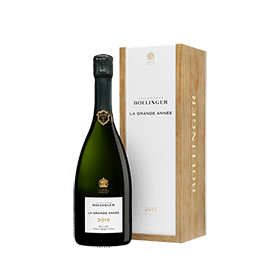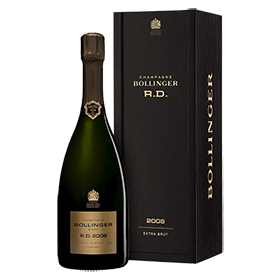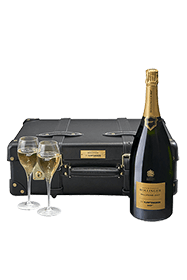The Timeless Sophistication of Bollinger Champagne
An inimitable style of elegance and excellence has shaped the spirit of Bollinger Champagne for nearly two centuries. Affectionately known as "Bolly", this legendary Champagne house has long seen its reputation spread across the world, winning the hearts of international wine lovers and critics. You too can enter the timeless and legendary world of an unmissable name in Champagne.
Sleek, stylish, powerful and complex, charming, smooth and debonair are just a few ways to describe the iconic British secret agent James Bond, as well as his favorite champagne, Bollinger. Established in the commune of Aÿ-Champagne in 1829, the House of Bollinger is home to an impressive legacy of winemaking excellence, achieved through the polished precision of a finely tuned timepiece.
In the cellar, tried-and-true ancestral techniques, such as hand-riddling, micro-oxygenation and barrel-making by the region’s last in-house cooper, are preserved at all cost, blending the classic sophistication of the past with the cutting-edge technology of the modern age to produce a wine with a timeless, enduring allure. The champagnes of Bollinger sparkle with a kind of slick, understated elegance through a blend dominated by lean and muscular Pinot Noir from the region’s most precious plots.
Location and size of the Bollinger vineyard
Founded in 1829 in Aÿ, in the Marne department, Bollinger oversees a vineyard of 179 hectares of vines. It is one of the few estates to grow its own grapes for its blends. Pinot Noir is the signature grape variety, representing 60% of the estate’s vines.
The History of the Bollinger Champagne House
A history dating back to 1829
Although he inherited some terroirs around Aÿ from his family, which he sensed had great potential, Athanase de Villermont could not embark on commercial activity because of his aristocratic status. His meetings with Joseph (known as Jacques) Bollinger and Paul Renaudin, respectively a major player in the champagne trade and a wine enthusiast, led to the creation of the company Renaudin-Bollinger & Cie on 6 February 1829. And so the Bollinger adventure began.
Georges Bollinger and his quest for quality
The son of Louise Charlotte Hennequin de Villermont and Joseph Bollinger, Georges Bollinger took over the running of the estate in 1899. Until his death in 1918, he faced with philosophy and dynamism two great challenges: the replanting of the vineyards ravaged by phylloxera over a period of more than twenty years and the dark times of the First World War.
The development era under Jacques Bollinger at the beginning of the 20th century
Following the death of Georges Bollinger, his father, Jacques instigated a major development of the estate, in its infrastructure and the purchase of vineyards. A few years later, Jacques Bollinger's death marked a real turning point. His wife, Lily, took over the family business at only 42 years old, with as much charm as elegance. A visionary and entrepreneur, she managed the estate wonderfully from 1941 to 1971 thanks to her modern spirit and innate business sense. She is remembered for her talent and her natural predisposition to uphold the lofty style of the house, and for being a woman of great passion and dedication.
Bollinger Champagne House, James Bond and Queen Elizabeth II
Enjoyed by wine lovers around the world, Bollinger Champagne has also become the official champagne of world-famous Secret Agent James Bond and of the English Crown. In 1956, Bollinger made its first appearance in Diamonds are Forever, the fourth Bond novel by Ian Fleming. In hopes of elevating the House’s signature product to the big screen, Christian Bizot met with Albert R. Broccoli, producer of the James Bond films, in 1979. This first meeting would eventually evolve into a strong friendship between the Champagne House and the James Bond franchise, resulting in frequent appearances of Bollinger Champagne on the silver screen. Since its first appearance in Live and Let Die, Bollinger has been featured in James Bond films 14 times. Bollinger is also the favorite champagne of the famous employer of 007, Queen Elizabeth II, who awarded the champagne the Royal Warrant in 1955. A historical favorite of the English Crown, Bollinger also received the Royal Warrant in 1884 from Queen Victoria and in 1950 from King George VI.
From 1971 to 2008, modernization and international expansion
In 1971, Claude d'Hautefeuille, husband of Madame Bollinger's niece, launched a vast modernisation of the estate’s infrastructure. Subsequently, Christian Bizot, Madame Bollinger's nephew, took over the reins of the estate and developed the distribution of Bollinger wines around the world.
The great-great-grandson of Joseph Bollinger, Ghislain de Montgolfier, took over the management of Bollinger from 1994 to 2008. He voluntarily limited volumes in order to favor quality while preserving the spirit and philosophy of excellence that has been the strength of the estate since its creation.
The 21st century: a house looking to the future
Since then, the estate has carried on this family heritage, mindful to respect the values that made it famous, while continuing to meet the challenges of our time with brio. Jérôme Philippon, the first non-family president, took over the reins of the estate in 2008, with a wealth of experience in renowned industrial groups. Under his direction, the most meticulous quality requirements were put in place, enabling the estate to rank alongside the greatest names in Champagne.
The quality of Bollinger’s range has continued to affirm its presence throughout the world. Since September 2017, Charles-Armand de Belenet has kept the flame alive with vigor, through a strategy of enhancing and modernizing skillsets with inimitable quality and identity.
Everything you need to know about Bollinger’s terroir
Location and exposure
Planted in the heart of the emblematic crus of Champagne, the 179 hectares of the Bollinger vineyard are divided into seven main vineyards, 85% of which are Grands Crus and Premiers Crus. While the terroirs of Aÿ, Avenay, Tauxières, Louvois and Verzenay (Montagne de Reims) are dedicated to Pinot Noir, that of Cuis (Côte des Blancs) exclusively grows Chardonnay, while that of Champvoisy (Marne Valley) develops Pinot Meunier.
The house also owes its singularity to two plots miraculously spared by the phylloxera that decimated the Champagne vineyards at the beginning of the 20th century. Located in Aÿ, the Clos Saint-Jacques and the Chaudes Terres produce an exceptional Bollinger Blanc de Noirs champagne, namely the Vieilles Vignes Françaises cuvée. In order to preserve these illustrious vineyards, the vines are worked manually using the ancient technique of provignage. This rarely-used method excludes grafting and consists of replanting new vine shoots by laying down a stump which then takes root by reproducing the characteristics of the original plant. Much more than a simple work of the land and the vines, the exceptional care given to this part of the vineyard pays tribute to the unique identity of historic Champagne.
Cultivation methods
As part of a sustainable viticulture approach, the estate allows grass to grow in the soil, while making very limited use of herbicides, maintaining organic insect control and flowers its plots. As a result, the house was the first in the region to receive the "High Environmental Value" state certification. Since then, the property has continued to meet its commitments by protecting and embellishing its exceptional natural heritage.
Winemaking
The best vintages are aged in 800,000 reserve wines and 3,500 small, old barrels. A true virtuoso of blending, Bollinger is the only house with such a collection. Thanks to this exceptional palette of Bollinger magnums, the full aromatic potential of each grape variety is revealed in blends with expressions that have a goldsmith's precision. Cellar Master Gilles Descôtes works with passion and rigor to preserve this precious nuance.
Much more than just a skill, the making of champagne is an art. Capturing the essence of each vintage and grape variety and transmitting it into exceptional wines, through a deep understanding of the singularity of each terroir, is the talent of this house. Bollinger makes it a point of honor to preserve traditions as a living heritage.
For that reason, the bottle turning and disgorging for exceptional vintages and large formats are done by hand, just as it was in former times, with respect to ancestral tradition. Bollinger is the only Champagne estate to have a cooperage on site, which allows it to have complete control over the manufacture of its barrels, from the choice of wood to the intensity of the heat.
From the vine to the bottle, Bollinger is an emblem of excellence and rigor. The estate is committed to respecting extremely strict requirements with an aging period that exceeds the rules of the appellation so that the magic of its champagnes works. With a minimum of three years of aging, each cuvée exudes a rare finesse, aromatic expression and refinement.
The Signature Style and Cuvees of the Bollinger Champagne House
Wine profiles
Over the years, Bollinger has dazzled with its signature style, with its identity shaped around the Pinot Noir grape. This demanding red variety represents nearly 60% of the vineyard, conferring vinosity, structure and complexity with an inimitable imprint. This style is revealed through low-dosage champagnes that never fail to delight with their unrivaled freshness and finesse.
Special Cuvée: Bollinger's historic champagne
Produced since 1911 and made from a blend of mainly Pinot Noir (60%), this Brut Champagne of character with a solid structure embodies the quintessence of a singular style. With its name with British overtones, Special Cuvée is associated with the long relationship between the estate and Great Britain. It was the estate's British agent who, finding the name "Brut sans année" unsuitable, suggested the name "Special Cuvée" to Georges Bollinger.
Granted the prestigious Royal Warrant, Bollinger has been on the list of official suppliers to the English Crown since 1884. This typically English image has led to it becoming the favorite champagne of the world's most famous secret agent. The James Bond franchise blends its universe with that of the house through the non-vintage Special Cuvée 007 or the 007 Limited Edition Tribute Moonraker.
This signature house style is best represented by their flagship non-vintage champagne, the Bollinger Special Cuvée. Made with 60% Pinot Noir, 25% Chardonnay and 15% Pinot Meunier, this champagne is aged in magnum bottles for 5 to 15 years and dosage with 8-9 grams per liter. Revealing notes of ripe fruit (roasted apples, peaches and apple compote) on the nose and a beautiful balance of structure, vivaciousness and length on the palate, this champagne will pair beautifully with raw fish dishes (sushi or sashimi), grilled shellfish, or aged Parmesan cheese. The pink non-vintage brut champagne Bollinger Rosé is made with 62% Pinot Noir, 24% Chardonnay and 14% Meunier, with only 5-6% red wine included in the blend due to the great power of the red grape. The aromas of fresh red berries (redcurrants, strawberries and cherries) in this rosé will go nicely with crayfish or salmon, along with fruit-based desserts.
La Grande Année: the enticing alchemy between rarity and finesse
The House’s flagship vintage champagne is the La Grande Annee, blended from wines vinified exclusively in wooden barrels. The 2012 vintage was fresh, full and complex, dosed with 8 grams per liter. On the nose, this vintage champagne reveals aromas of apricots, toasted almonds and hazelnuts, while the palate is dense and silky with a very long finish. This champagne shines best paired with scallops or truffle-infused dishes. It is also produced as a rosé, the Bollinger La Grande Année Rosé, whose blend contains 5% red wine from the estate’s Cote aux Enfants Pinot Noir. Its notes of redcurrant and black fruit will pair nicely with sauteed duck beast, pigeon or venison.
Cuvée R.D. : a symbol of creative audacity
Lastly, the Cuvée R.D. - "Récemment Dégorgé" (recently disgorged) - highlights the infinite refinement that the estate has shown since its birth. Conceived by the legendary Madame Bollinger, it was in the 1960s that this R.D. "Récemment Dégorgé" was unveiled, a vintage Extra Brut champagne aged on its lees, offered for tasting just after disgorgement.
Freed from the codes of the time, Bollinger R.D. "Récemment Dégorgé" reveals a unique taste that started a revolution in the world of champagne. Only produced in the best years, this exceptional Extra Brut champagne reveals the exceptional aromatic expression of its original vintage in a cuvée that has taken the time to develop while retaining its aromatic brilliance.
Madame Bollinger was not wrong when she famously said: "Every great moment in life deserves its own Bollinger champagne."
Respect for tradition, hand turning of bottles, corking of reserve magnum bottles, the last barrel maker in the Champagne region: this precision and taste for excellence symbolize the whole culture of Bollinger champagne. More than an art, it is a heritage.
The Bollinger R.D. is the House’s bold and brilliant prestige champagne, made from 88% Grands crus and 12% Premiers crus. The initials R.D. stand for “récemment dégorgé” or “recently disgorged,” referring to the fact that this cuvee is released just a few months after its disgorgement, resulting in a very fresh wine. The dosage is very low here with just 3 grams per liter. Displaying a deep gold color in the glass, the 2004 vintage of the Bollinger RD reveals stewed fruits, sweet spices and preserved orange peel on the nose, while the palate presents a grand generosity. Pair it with refined dishes, such as roasted scallops or pigeon, followed by aged Gruyere. At the top of the range is the Bollinger Vieilles Vignes Françaises, a vintage champagne made with Pinot Noir from the non-grafted vines of the estate’s two old plots. This exclusive champagne receives no dosage and reveals an incredibly complex, lively and smooth nose.
Storage
Bollinger Rosé, Blanc de Noirs, plot-based, recently disgorged vintage champagnes: the signature of this illustrious house is revealed through emblematic cuvées, all with a unique personality and great aging potential which, after several years in the cellar, brings out the aromatic depth and remarkable character of these exceptional champagnes.











